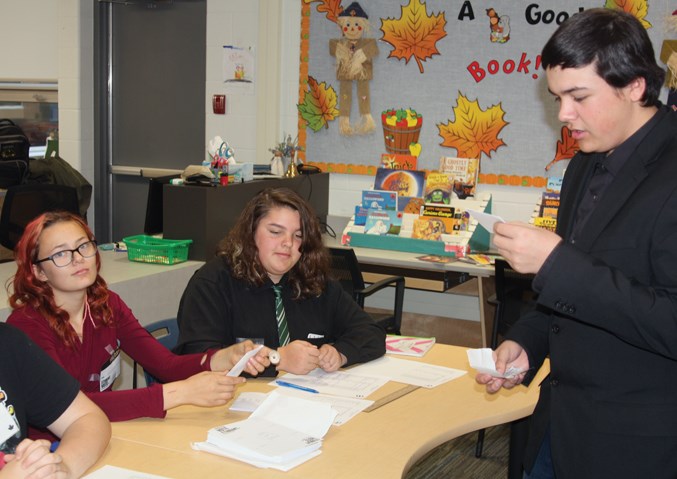If it were up to the kids of Canada, the results of the Oct. 21 federal election would have looked very similar, with the Liberals forming a minority government, but the Conservative Party leading the way in Alberta.
Nearly 1.2 million elementary and high school students from across 8,005 schools in Canada’s 338 ridings would have elected the Liberal Party and leader Justin Trudeau to a minority government. Student Vote Canada is held in conjunction with the federal election to help introduce students to the electoral process and the importance of fulfilling your responsibility as a member of a democratic society.
Six schools in the Westlock region including Westlock Elementary School, R.F. Staples School, St. Mary School, Busby School, Eleanor Hall School and Pembina North Community School took part in the mock election on different days during the Oct. 14-18 week and had their say in the Peace River-Westlock riding.
“I think it’s really important to help the kids understand the voting process and become engaged in it,” said PNCS Social Studies teacher Carling Montgomery. “Voter turnout is not great in this country. In 2015 it was 68 per cent I believe and that’s still one-third of Canadians not voting.”
Montgomery said she also learned from the organizers of Student Vote that after hearing about their children’s’ experience at school, many parents have taken to the ballot box for the first time.
“They’re seeing that students in these programs are now going off and voting or becoming even more involved in the political process, working at polling stations or whatever, so that’s absolutely what we are after.”
Federally, the Liberals won 22.3 per cent of the popular vote and won 112 seats, followed by the NDP with 24.8 per cent of the popular vote and 98 seats. The Conservatives had more of the popular vote at 25.1 per cent, but won just 93 seats. The Green Party won 18.1 per cent of the vote, for 27 seats, while the Bloc Quebecois won 12 seats with 1.3 per cent of the vote.
While the vote for the kids was off the results of the actual election as far as who would sit in the Opposition benches, the Alberta numbers saw nearly the same finishing position, but percentages were off. The Conservatives won 46.1 per cent for 30 of Alberta’s 34 seats, the NDP had 21.2 per cent for three seats and the Liberal Party won one seat with 10.9 per cent of the vote.
Breaking the numbers down further into the Peace River-Westlock riding, Conservative Arnold Viersen won 58.84 per cent of the vote (more than 20 percentage points lower than his actual results), while NDP candidate Jennifer Villebrun won 13.4 per cent of the vote. Green Party candidate Peter Nygaard finished third in the student vote with 11.11 per cent, just a few points higher than Liberal Party candidate Leslie Penny. People’s Party candidate John Schrader finished with 5.41 per cent.
At Busby School, Viersen was named winner with 42.31 per cent of the 26 votes cast, followed by the Greens, NDP, People’s Party and the Liberals. At Westlock Elementary School, the Conservatives were again in the lead with 70.31 per cent of the 64 votes cast. They were followed by the NDP, Liberals, Green Party and People’s Party.
At Eleanor Hall School in Clyde, the Conservatives were declared winners once again, but the margin was much smaller with Viersen winning 34.83 per cent of the 89 votes cast.
Villebrun received 28.09 per cent, followed by the Greens, Liberals and People’s Party.
At PNCS, the Conservatives won the majority with 50.45 per cent of the 111 votes. The Liberals got 16.22 per cent while the NDP, Greens and People’s Party lagged behind.
Thirty-nine students from St. Mary School also cast their ballots and 56.41 per cent went to the Conservatives. The NDP, Liberals, People’s Party and Greens followed.
Over at R.F. Staples, where 351 students cast their vote, 64.39 per cent were cast for Viersen and the Conservatives. The NDP had 12.25 per cent, followed by the Greens, Liberal and People’s Party.
R.F. Staples associate principal Jason Wiks also teaches Grade 9 Social Studies, which includes a study of decision-making at a federal level.
“We do a lot of work around how we select our representatives and which ones we vote for and which ones we appoint,” said Wiks. “Generally speaking it fits really well into the Social Studies curriculum around responsible citizenship, understanding from a process point of view, how and why we do certain things and why a secure voting system is important.”
Students tend to show an interest as it provides an opportunity for a very hands-on learning experience that is very interactive, with the political parties contributing to the process however they can, said Wiks.



